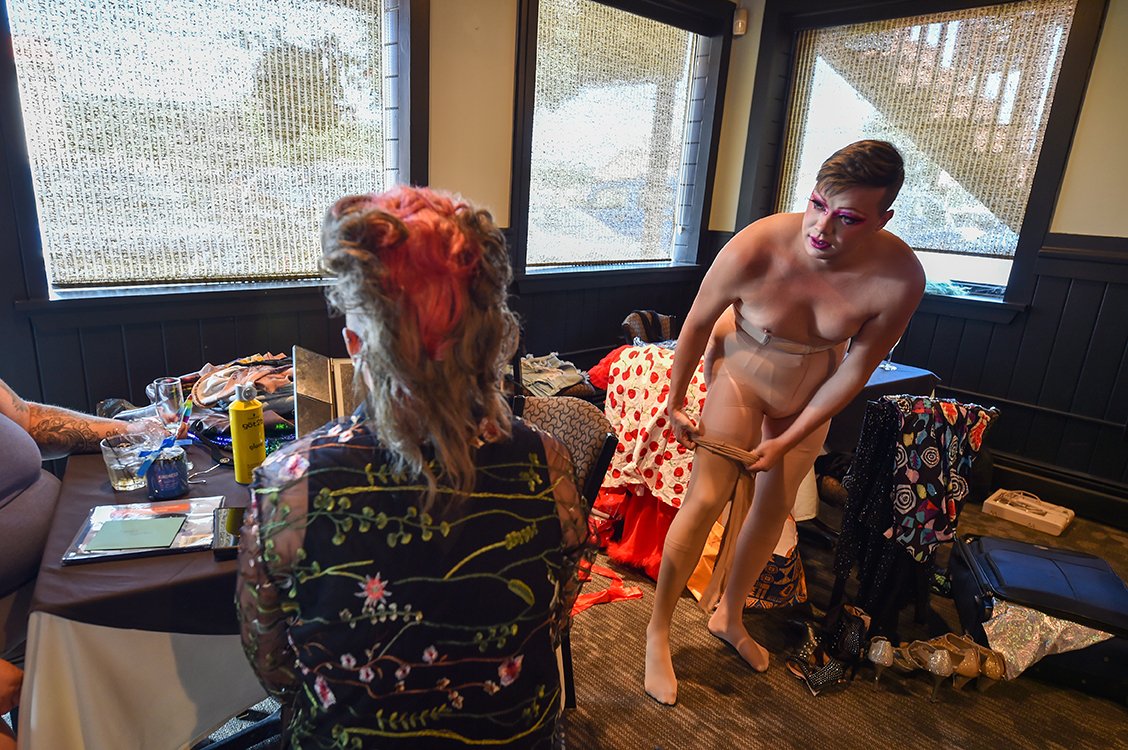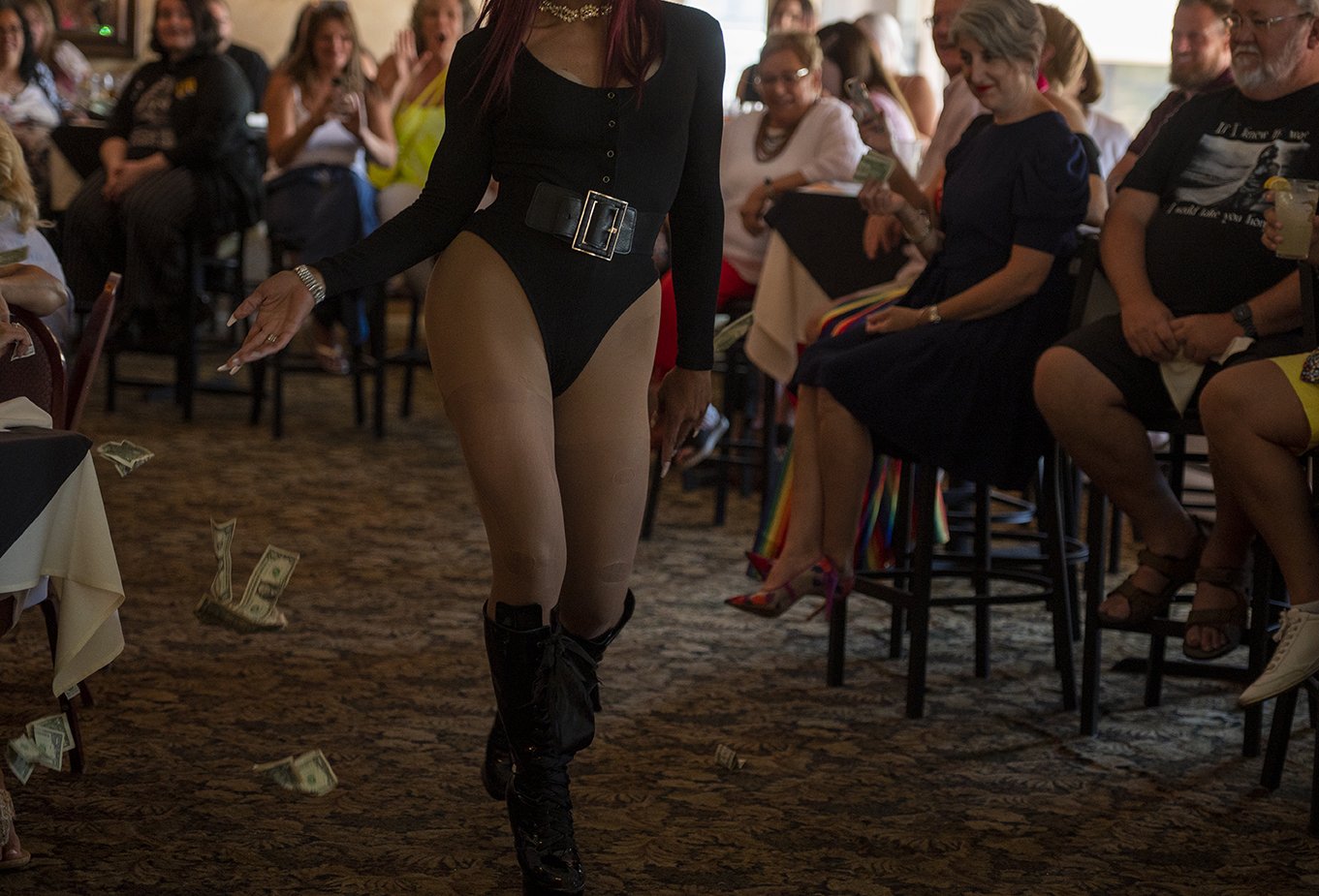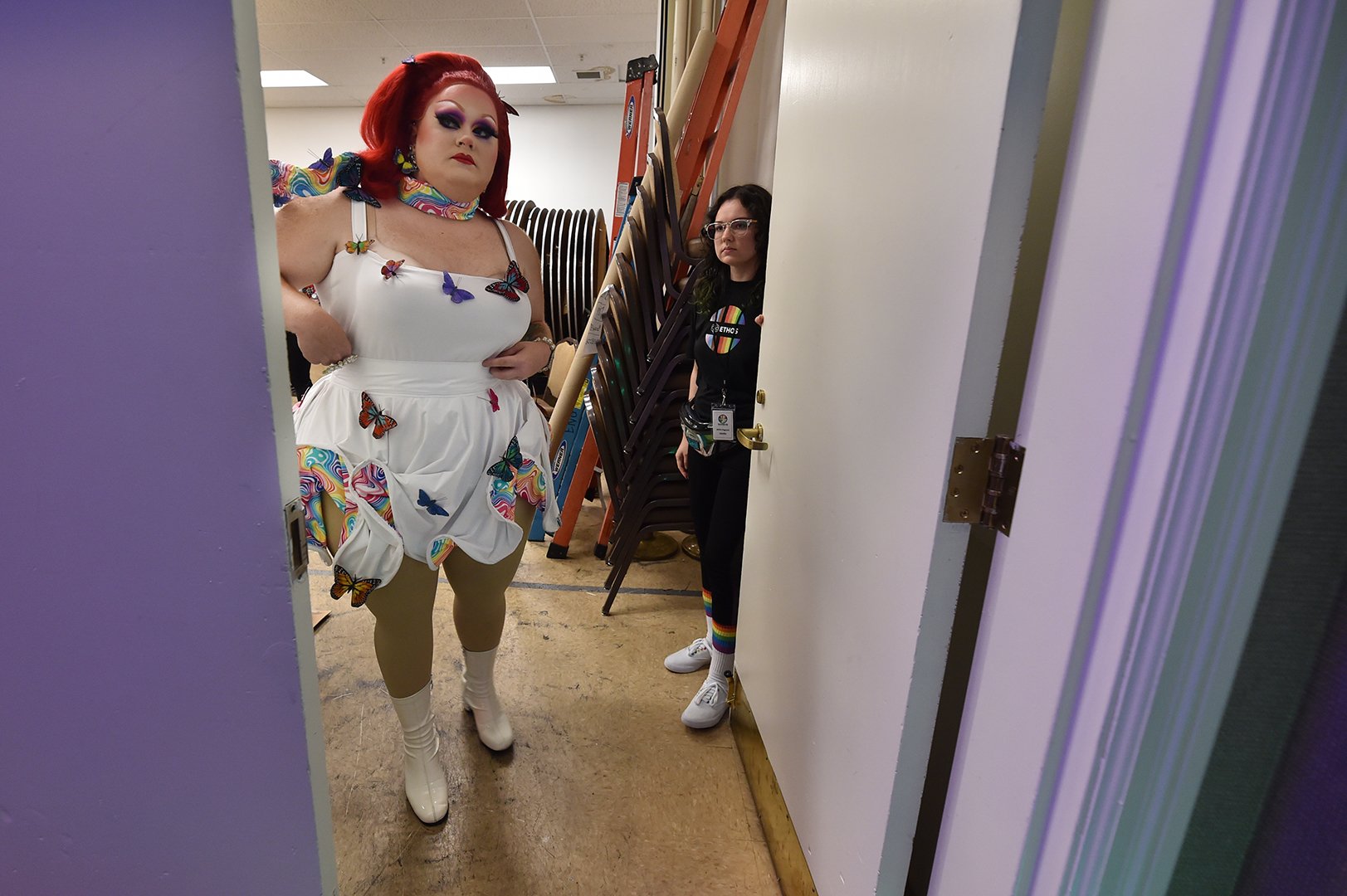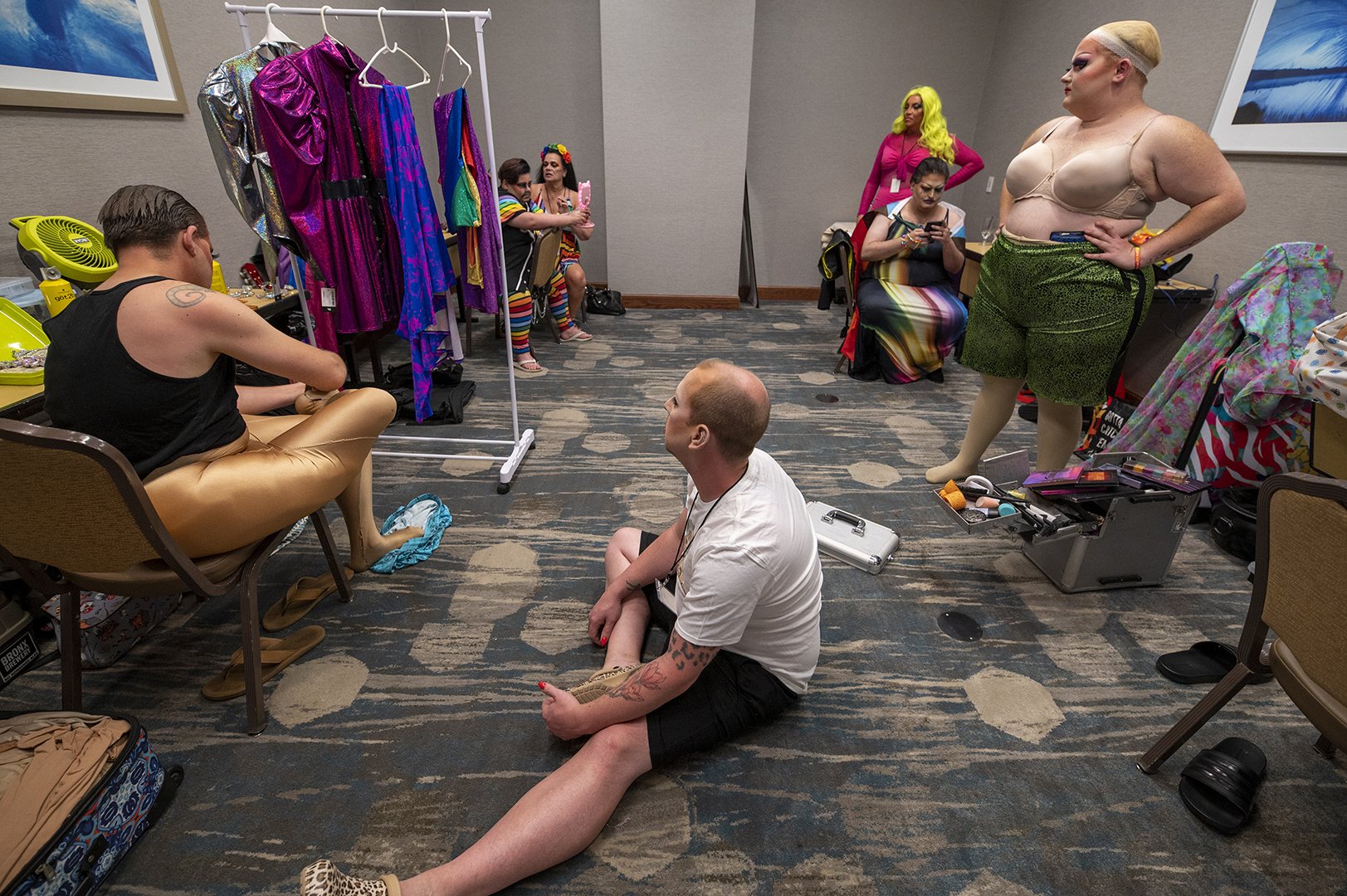How Drag Has Driven Acceptance and Inclusion for NEPA’s LGBTQ Community
Photos by Aimee Dilger | Video and Article by Kelly Dessoye
Trixy Valentine scampers onto the stage amid the thunderous beat pulsing from loudspeakers at Damien’s on the Lake in Harvey’s Lake, PA.
She stomps down a catwalk flanked by the cheers of an expectant crowd fueled by mimosas and anticipation. She twirls, sashays, lunges, teases - strobe lights catching rhinestones decorating her eyes, alight with mischief. Mouths hang agape hungry for more, and she’s only too willing to comply. She tugs the end of a belt and her soft red robe tumbles to the ground revealing bare shoulders and lingerie. The crowd loses it - yipping and hollering as dollar bills fall from their hands and to her feet. Drag, it turns out, has found a welcome home in Northeastern Pennsylvania but a few short years ago this felt like a pipe dream.
Drag in Northeastern PA - or NEPA - has been around since at least the 1970s. Back then drag shows, which have origins in The Ballroom Scene - a queer subculture born in 1970s New York to foster inclusion and self expression for queer and trans people of color - were called “Powder Puff Reviews” and were announced as adverts in local newspapers such as The Times Leader promising “4 female impersonators” at the now shuttered Hi-Lite Lounge and Restaurant in Kingston, PA.
An ad in The Times Leader from September 2, 1970 for a “Powder Puff Review” show, courtesy of The Luzerne County Historical Society
As recently as 10 years ago, drag in NEPA was still underground - performers creating a chosen drag family to lean on for support, expression, and safety - a necessity in an area that wasn’t all that safe for a queer person. “I’ve known NEPA, in my experience, not to be the most accepting…friendliest," says Jacob Kelley, also known as the aforementioned drag queen Trixy Valentine. “I’ve been chased down by cars, I’ve had things thrown at me while I was walking down the street.”
Justin M. Correll remembers his first Pride as exhibiting a similar air of bigotry.
“I remember attending my first Pridefest over at Kirby Park with police and an orange fence and a pavilion, and you were confined to the pavilion itself…because people were protesting, people were angry, people were throwing things. [Now] there is a full cultural change. People now have an open mind, they’re accepting. They’re looking to bring diversity, equity, and inclusion into their work places.”
If you ask Jacob Kelley, drag has a big hand in that shift. “Drag has been the driving force to help acceptance and inclusion for the LGBTQ community to be represented, to be heard, to be seen - to fight those barriers and stigma that we have to face every day. Drag in NEPA is one of the factors that allows us to show that we exist … and we’re allowed to exist.”
Correll, who co-chairs the NEPA Pride Project and chairs the Rainbow Alliance, credits the shift to the visibility ushered in by widespread media attention through shows like RuPaul’s Drag Race and a recent surge in migration from New York, Pittsburgh, and other metropolitan areas that have already woven cultural progress into their ethos. Now drag - once perceived as a spectacle or guilty pleasure - is seen as an elevated art.
“Drag is definitely an art form, “ says Correll. “Someone expresses their time, their talent, their energy, their passions for entertainment. [From] every drag performer whether it’s a king or a queen, someone that plays both roles, someone that plays neither role, you see individualized personas and every drag performer is different.”
Performers range from wickedly sharp standup comedy to choreography, lip syncing, live musical performance, and every other performance under the sun. “It doesn’t really matter how you were born, whether you’re cis male or cis female, drag is just interpretive art,” says drag king Xander Valentine, sitting at a table strewn with costumes, wigs, and dustings of glitter speckled powder. “[Drag Kings] used to just be trans men or people who were already masculine in their daily lives. I’m feminine in my daily life so for me it’s a whole transition.”
“[Drag Kings] used to just be trans men or people who were already masculine in their daily lives. I’m feminine in my daily life so for me it’s a whole transition.”
That transition goes beyond the surface. “I change my body shape with couch cushions, and lots of pantyhose,” says Eileen O’Brennan as she swipes liquid eyeliner around brilliant blue eyes. Eileen, a bartender known as Tommy in their other job, has been performing as a drag queen for around 10 years. “It started as a joke with some friends and has become quite the job. The wigs and the jewelry and the shoes all take up their own bedroom and sometimes other parts of the house too.” That dedication to artistry can run up quite the tab. Eileen recently spent upwards of $500 between custom made costumes, props, and wigs for a single drag pageant; all in the name of professionalism and elevating artistry.
Other performers like Dakota Noel, who goes by the stage name Sedusa, make their own costumes. “I just recently quit my job to do sewing and drag full time,” says the 21-year old who is gaining renown throughout the drag community for custom creations that hug every curve of a transforming body.
Entertainment aside, individuals like Jacob Kelley use drag as a powerful communication device. Kelley - a queer educator hailing from Nescopeck at the very edge of Luzerne County - lives and breathes education and inclusion whether presenting as themself or Trixy Valentine. They started Mx. Kelley Queer Education to promote sexual education, inclusivity, and advocacy for LGBTQ individuals residing in rural strongholds that are slow to acceptance and they credit drag with helping them to learn to love their gender. “Gender is based off of this binary that someone has to be a man or a woman and nonbinary [is a gender that] takes those two and is like nope.” Their hand swipes a table, pushing aside invisible societal constructs. “You can be anywhere, not exclusively male or female. I learned I was nonbinary because of drag.”
“Gender is based off of this binary that someone has to be a man or a woman and nonbinary [is a gender that] takes those two and is like nope.” Their hand swipes a table, pushing aside invisible societal constructs. “You can be anywhere, not exclusively male or female. I learned I was nonbinary because of drag.”
But Kelley is adamant that drag is for everyone. “People think that if there’s drag you have to be part of the LGBTQA+ community. You don’t. Drag is an art form and expression that you get to use solely based on yourself for whatever reason. Essentially yes, it’s from our culture and history but you don’t have to be of that community to do it. It would be wrong of us to gatekeep.” And according to Kelley, they’ve found that NEPA’s cisgender heterosexual community is curious about queer culture, particularly drag. “I’ve learned that it helps build bridges because now we can have a conversation.”
Part of that outreach happens through organizations like the NEPA Pride Project and the NEPA Rainbow Alliance, who sponsor and organize events like this year’s inaugural Pridefest Royale Drag Pageant, the Gayla, and the recent Drag Brunch held at Damien’s on the Lake, which attracted people of all genders and orientations ranging in age from 21 to over 70. “Drag is something you don’t have to go to a big city to see anymore through organizations such as ours. It is making it more approachable to people who wouldn’t ordinarily go and see a show,” says Emily Churchfield, who serves as vice chair of the the NEPA Pride Project and on the marketing and special events committee of the NEPA Rainbow Alliance. She brought her dad to the NEPA Pride Project’s Drag Brunch. “My dad - a rugby player, from England - was not really exposed to LGBTQA+ culture growing up. He was at the Drag Brunch and said to me, ‘Emily, that was fabulous.’” She erupts in laughter.
The NEPA Pride Project - co-founded by Correll and his childhood friend Martha Zabriski - funnels donations into a scholarship fund for LGBTQ youth and high school seniors who are interested in the arts. This includes various visual and performing arts such as graphic design, painting, metalsmithing, ballet, and vocal arts. “The reason we focus on [the arts programs] is that a lot of the LGBTQ+ youth look to the arts as an outlet to get out frustrations, to get out emotional feelings, to try to find their home … so this gives them a way to pursue college, pursue a career, in the field of their choice,” says Correll, “and they become part of our little family because not everyone is as fortunate as Martha and myself with supporting families - people that have their back.” Zabriski chimes in, “it gives people in the LGBTQA+ community a chance to be involved in something different, be involved in their community.”
This is especially true of the annual Gayla - held this year on September 24 at Genetti’s in Wilkes-Barre. The Gayla, also hosted by the NEPA Pride Project, is a celebration and networking event for NEPA’s LGBTQ community and allies. Like the Rainbow Alliance sponsored Pridefest and Pridefest Royale pageant, all funds earned through ticket sales and donations are used toward the event itself. Any money left over is recycled into scholarship funds.
The Rainbow Alliance Pridefest Royale Pageant, directed by Jacob Kelley, is a pageant where queens and kings from all over Pennsylvania compete to be crowned the NEPA Pridefest Royale. Although the winner receives a sash and crown designed by the same artist who creates crowns for RuPaul’s Drag Race, the biggest prize is the platform afforded by the Rainbow alliance. For their tenure as Royale, the winner is supported and amplified by the Rainbow Alliance and in turn acts as an ambassador by hosting fundraising events, community initiatives, and appearances on behalf of local queer organizations like the Rainbow Alliance, Queer NEPA, and the NEPA Pride Project. This year Eileen O’Brennan modeled, danced, and entertained the over 200 person crowd on her way to the crown.
“Most events like this you’d get 10 people in a room and they’d be your closest friends and we’d be like ‘we’re here for eachother’ but to get a community in a room that’s here for you speaks volumes, especially for LGBTQA+ people,” reflects Kelley.





















